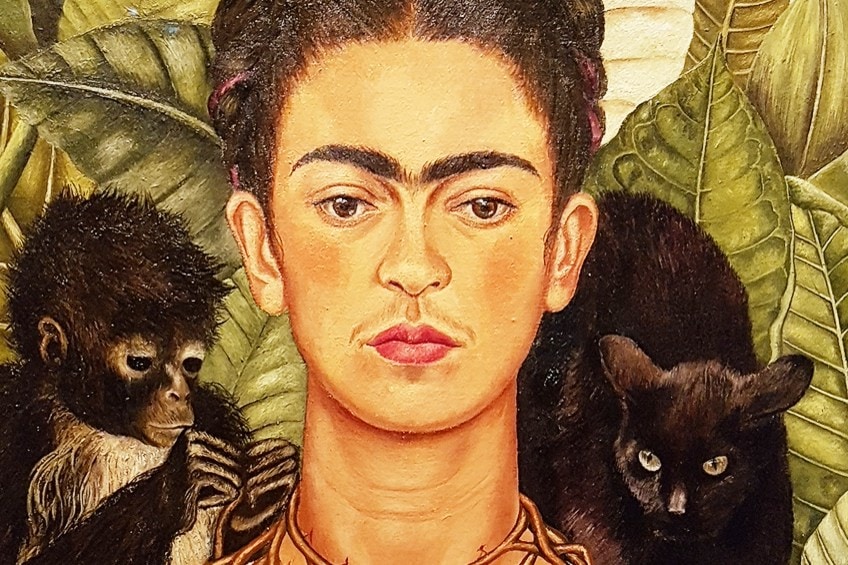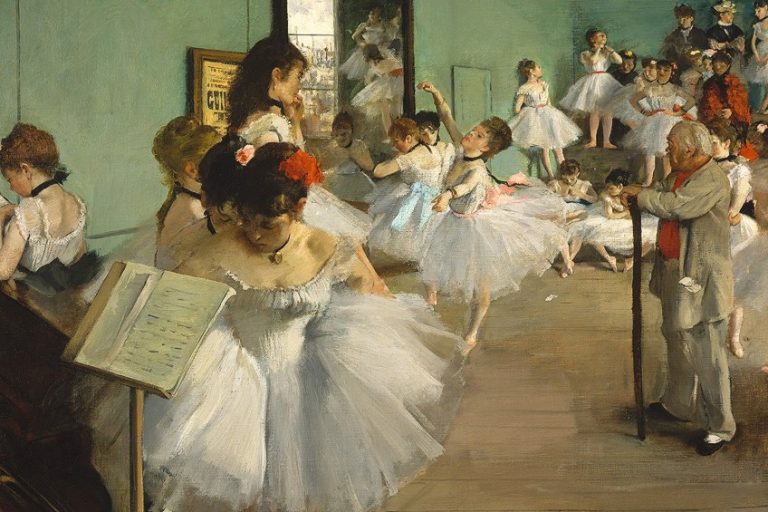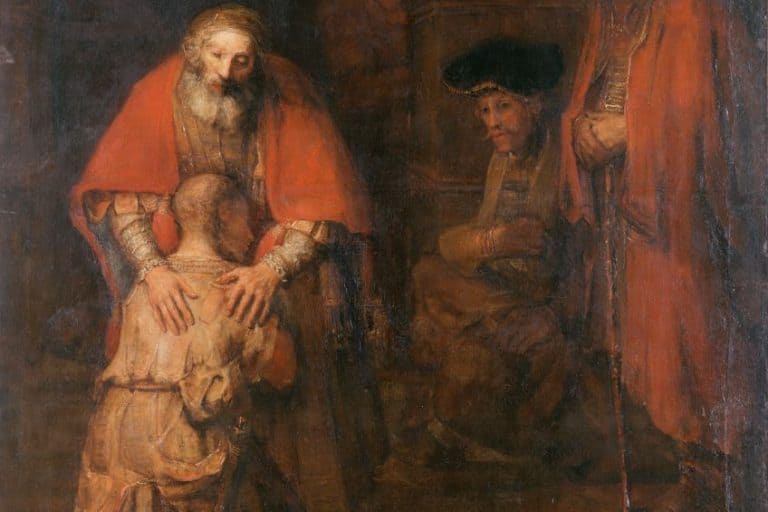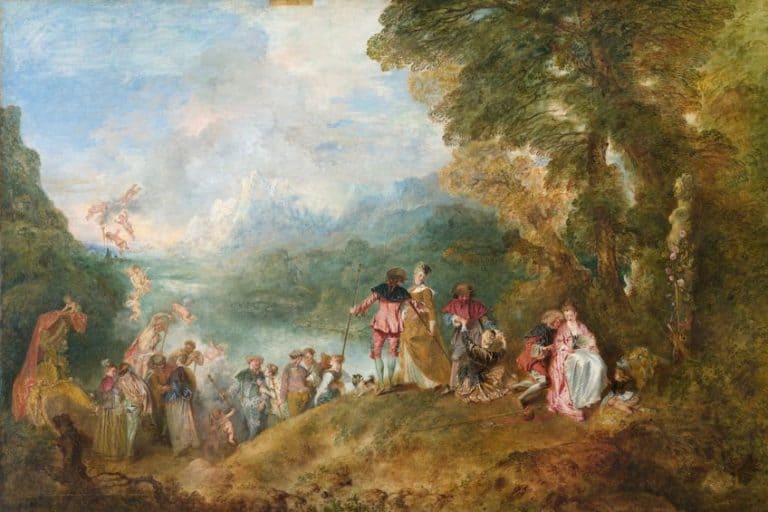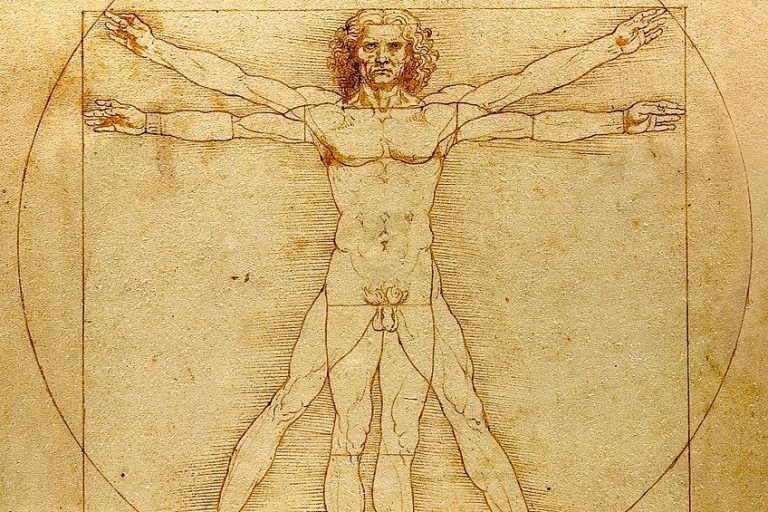“Self-Portrait with Thorn Necklace and Hummingbird” – Frida Kahlo
Frida Kahlo’s life was not always an easy one, but her hardships and endurance were given a visual voice through her numerous self-portrait paintings. One of these includes her famous thorn necklace painting and the topic of this article.
Artist Abstract: Who Was Frida Kahlo?
Frida Kahlo’s birth date is July 6, 1907, and she died on July 13, 1954. She was born in Coyoacán in Mexico City and grew up at what was called “The Blue House”, or La Casa Azul, which was her family home. Her father was Carl Wilhelm Kahlo (later called Guillermo) and her mother was Matilde Calderon y Gonzalez. She had three sisters and two half-sisters.
Kahlo suffered numerous hardships in her life, and the most notable was a bus accident in 1925, which left her with multiple broken bones and fractures and a punctured uterus and abdomen.
She started painting after her accident, but she was always interested in art; her father was a photographer, and Kahlo would assist in his studio as well as learn drawing from Fernando Fernandez, who was a printmaker and friend of her father’s. Kahlo produced numerous notable paintings throughout her career, all inspired by her rich inner world as well as her passion for politics, activism, and her heritage.
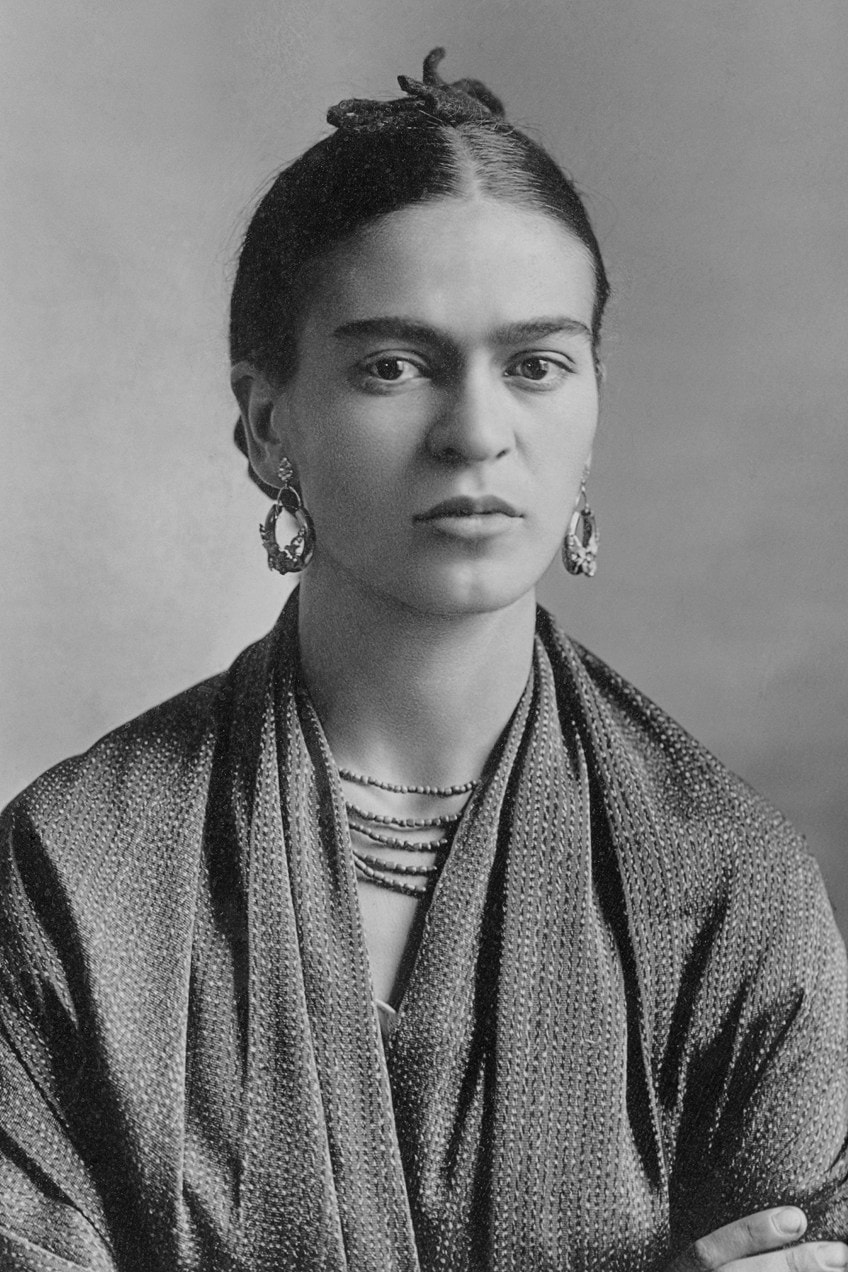
Self-Portrait with Thorn Necklace and Hummingbird (1940) by Frida Kahlo in Context
Self-Portrait with Thorn Necklace and Hummingbird is a famous Frida Kahlo self-portrait and one that she painted at a tumultuous time in her life. Below, we will start with a brief contextual analysis exploring the events that inspired this thorn necklace painting as well as the symbolic meaning. This will be followed by a formal analysis, describing the subject matter in more detail, and looking at the various elements of art and principles that Kahlo utilized to create this composition.
| Artist | Frida Kahlo |
| Date Painted | 1940 |
| Medium | Oil on canvas |
| Genre | Portrait painting |
| Period / Movement | Mexican painting, Magic Realism, Surrealism |
| Dimensions (cm) | 62.5 x 48 |
| Series / Versions | N/A |
| Where Is It Housed? | Harry Ransom Center, Austin, Texas, the United States |
| What It Is Worth | The painting was bought by Nickolas Muray after it was painted and acquired by the Harry Ransom Center in 1965/1966. The exact price is uncertain. |
Contextual Analysis: A Brief Socio-Historical Overview
When Frida Kahlo painted Self-Portrait with Thorn Necklace and Hummingbird, she was just coming off a divorce from Diego Rivera in 1939. Diego Rivera was always a significant figure in Frida Kahlo’s life and her career as an artist, and importantly, there cannot be mention of Kahlo without a mention of Rivera. Rivera was a famous muralist when Kahlo met him in 1922 when she was in high school, however, she later met him again through a friend in 1928 and they married in 1929.
They were remembered as having numerous difficulties that lead to intense heartbreak in their relationship, and both also had extra-marital affairs.
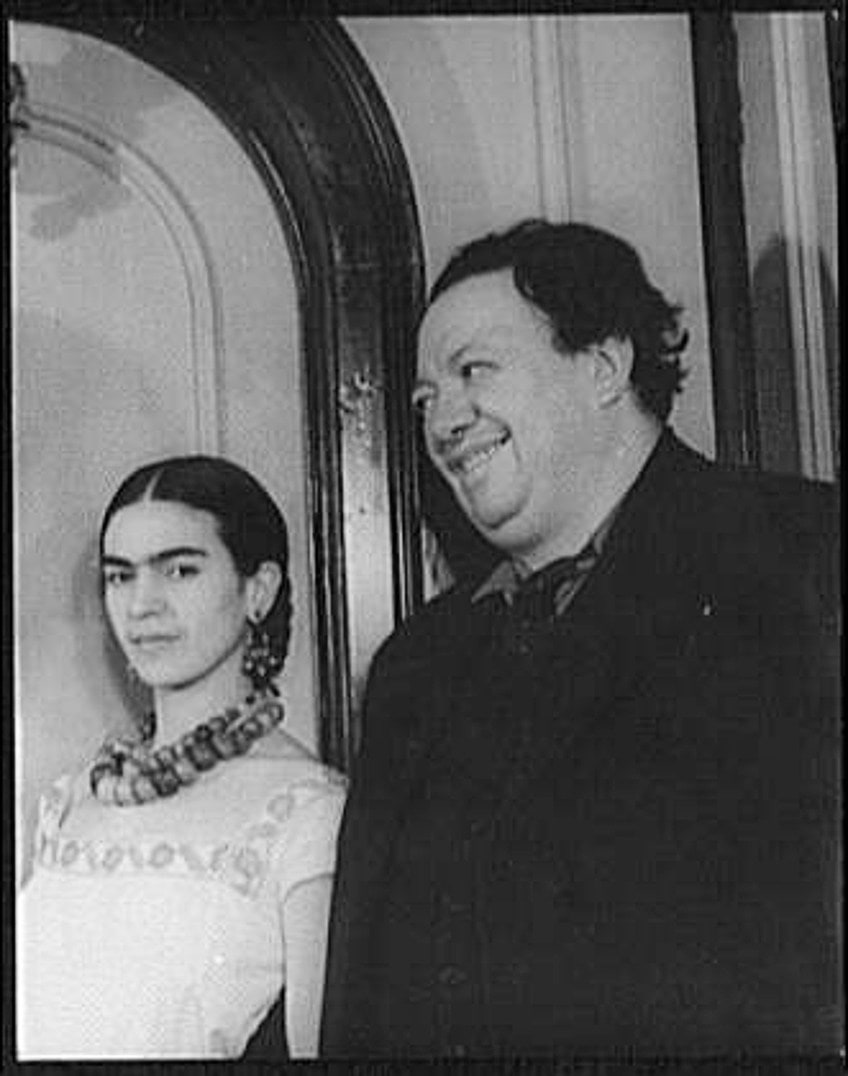
One of Kahlo’s affairs, almost a decade long, was with Nickolas Muray, a photographer she met in 1931. According to several letter correspondences between the two, they were fond of one another and seemingly in love too, Kahlo often referred to him as “my sweet” or “my darling”. However, Kahlo’s relationship with Rivera would always take precedence, and in 1941, Kahlo and Muray’s love affair ended, but they remained close friends.
Regardless of all their hardships, Kahlo and Rivera remarried in 1940.
Frida Kahlo’s Symbolism
Considering the events in Frida Kahlo’s personal life between 1939 and 1940, Self-Portrait with Thorn Necklace and Hummingbird is filled with symbolism that ultimately expresses her inner world throughout this time.
Kahlo often painted symbolically, with herself as the main protagonist, incorporating religious, political, cultural, gender, and ancestral motifs intricately bound to ideas of martyrdom, loss, pain, grief, love, colonialism, identity, and her political and philosophical ideals as well as her Mexican heritage.
Additionally, Kahlo also portrayed animals to convey deeper ideas; she had numerous animals like spider monkeys, parrots, dogs, cats, and more, all of which undoubtedly inspired her and found a place in her self-portraits. In Self-Portrait with Thorn Necklace and Hummingbird, there is a spider monkey, a black cat, butterflies, dragonflies, and the eye-catching hummingbird hanging from its beak from the thorn necklace around Kahlo’s neck. What do all of these symbolize?
Some believe the painting symbolizes resurrection and the pain from her relationship with Rivera. The spider monkey could be a reference to Diego Rivera because he gave Kahlo a spider monkey. Additionally, the monkey is believed to symbolize evil. The monkey is seemingly playing with a part of the thorn necklace around Kahlo’s neck, which appears to cause more pain, as is evidenced by the bleeding cuts on her neck.
This could mean that monkey has a negative and painful effect on Kahlo, and if it is a symbol of Diego Rivera, he undoubtedly caused her pain when they divorced.
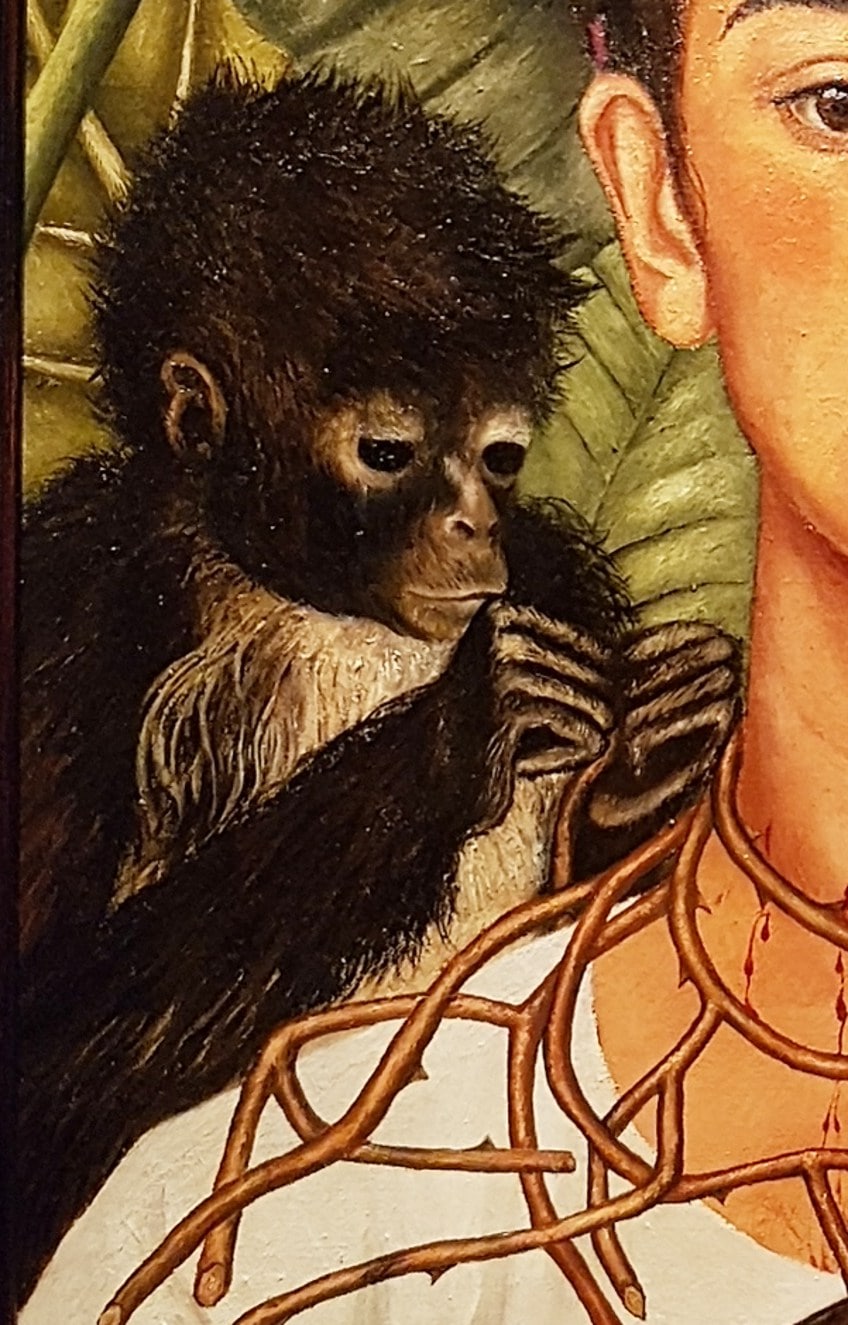
The thorn necklace could allude to the idea of martyrdom, and here Kahlo becomes the martyr wearing it. This also alludes to the religious narrative that relates to the crucifixion of Jesus Christ and when He wore the crown of thorns. Some suggest that Kahlo could be likening herself to Jesus Christ Himself.
This idea is further highlighted by the butterflies and dragonflies, which symbolize resurrection and could hint at Kahlo becoming renewed after her pain and hardships, as well as the white blouse (or robe?), which could symbolize purity.
The hummingbird hanging in the center of the thorny necklace is believed to symbolize good luck, which is one of its more common symbolic meanings. It can also be a symbol of the Aztec god of war Huitzilopochtli who was depicted as a hummingbird in Aztec art. However, the hummingbird was also a symbol of rebirth to the Aztecs, especially that of passed-over warriors.
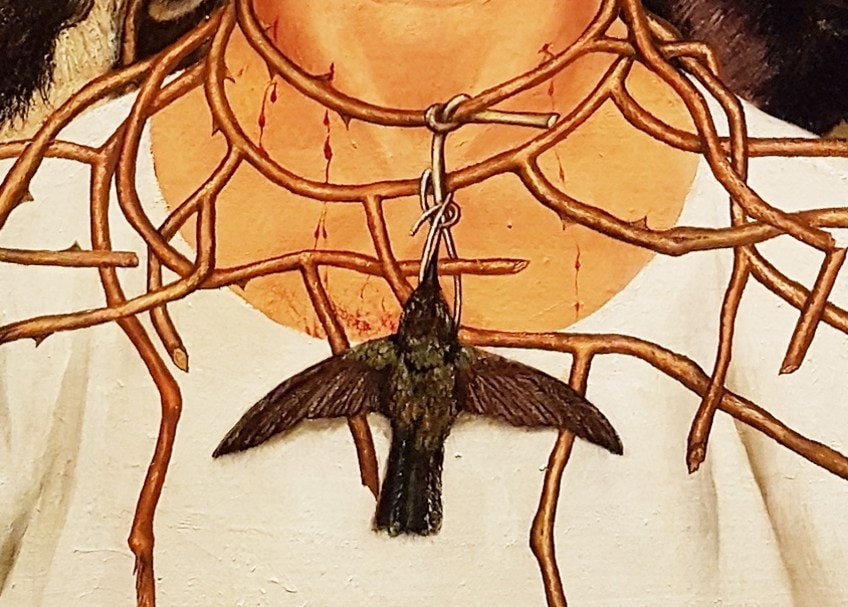
The fact that the hummingbird is lifeless could indicate a loss of hope or strength on Kahlo’s part including an idea of conflict or a personal war that Kahlo experienced. However, there could exist numerous potential meanings for a dead hummingbird.
Furthermore, the black cat is also a symbol of bad luck, which could further indicate Kahlo’s feelings of misfortune and heartbreak.
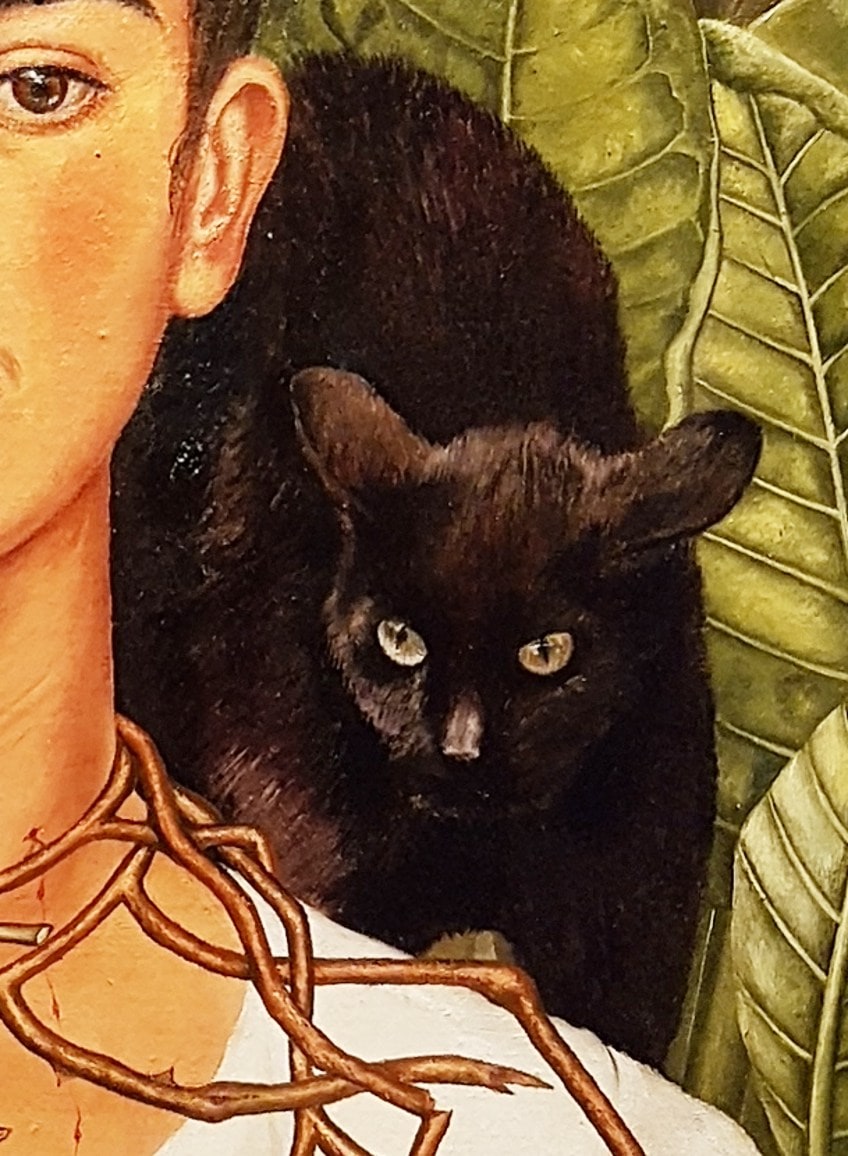
If we look at the entire composition, the background is filled with foliage and greenery, which could indicate growth and life. This contrasts with the foreground, which is more associated with ideas of death, pain, and loss. Self-Portrait with Thorn Necklace and Hummingbird is almost like part of a visual diary by Frida Kahlo, one that poignantly depicts the artist as the protagonist of her circumstances.
Perhaps she is neither the victim nor the heroin, but merely a self-reflection that enables her to express her deep, innermost, caverns where she holds all her heartbreak.
Frida Kahlo reportedly painted 55 self-portraits, and interestingly, we will find similar symbols, and Kahlo portraying herself. For example, we will find more of her beloved monkeys in the Frida Kahlo self-portrait titled Self-Portrait with Monkeys (1943). Other Frida Kahlo self-portrait examples include The Broken Column (1944), and The Wounded Deer (1946).
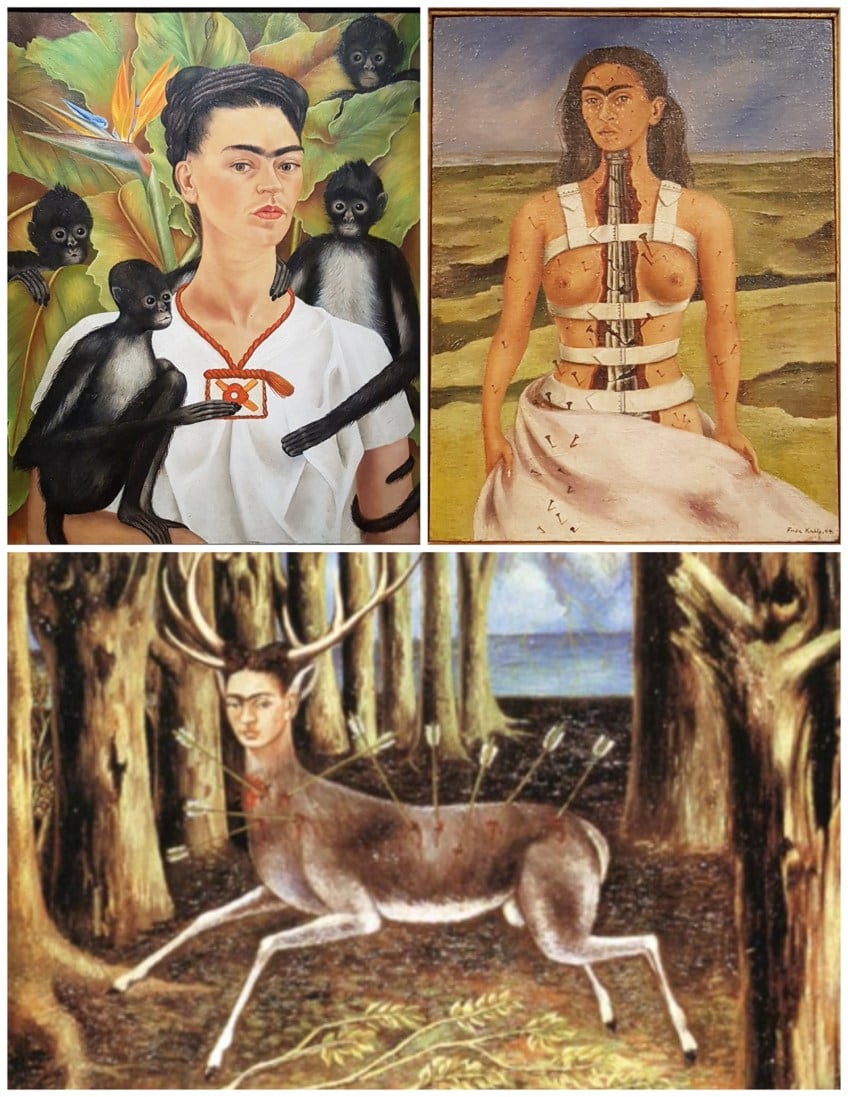
It is also important to note that Kahlo was a multi-passionate woman, she held strong beliefs and celebrated her ancient Mexican heritage, expressing this through wearing traditional clothing. She also stood strong as a Mexican nationalist; she held an interest in politics as early as high school and was engaged in activism until her death.
Furthermore, Frida Kahlo was a pioneering female artist, she touched on numerous aspects of being a woman, from sexuality, identity, fertility, and more. She has become a leading inspiration to many feminist artists to date.
Formal Analysis: A Brief Compositional Overview
Below we will look at a formal analysis of Self-Portrait with Thorn Necklace and Hummingbird by Frida Kahlo. We will first provide a visual description and then look at artistic techniques in terms of art elements and principles.
Subject Matter: Visual Description
In the Self-Portrait with Thorn Necklace and Hummingbird by Frida Kahlo, she is facing us, the viewers, in a full-frontal stance just exposing her upper torso, neck, and head. She is wearing a white blouse (or possibly a dress or robe) and her hair is held up in what appears to be plaits on either side with two butterfly clips.
She is surrounded by fauna and flora.
The background is filled with foliage, notably large leaves that are mostly green with some hints of yellow. There is a light-yellow leaf peeking out from behind her head to her left (our right). By her right shoulder (our left) is a black monkey and by her left shoulder (our right) is a black cat. There are two dragonflies flying above Kahlo’s head. There is a hint of blue sky in the topmost section of the composition.
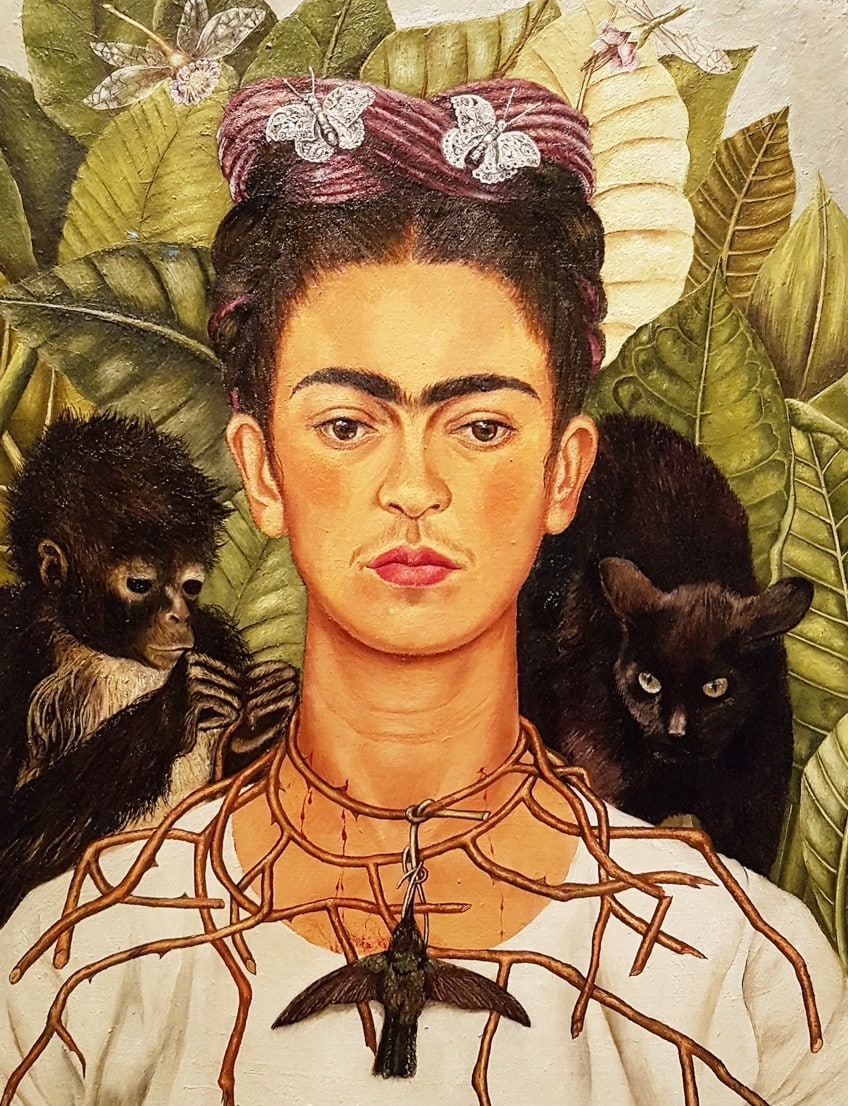
There is a hummingbird hanging from its beak, with open wings, from a thorn necklace around Kahlo’s neck; the necklace extends all the way down her upper chest area, and we can see droplets of blood trickling down her neck from where it is piercing her skin. The monkey by her right shoulder (our left) is busying itself with a piece of the thorn necklace.
Her facial expression appears almost blank in her stare, but there is also a seriousness or solemnity to her, and we wonder what she is going through. Some sources also suggest that she is enduring pain from the thorn necklace, but also the emotional pain of what it all symbolizes as mentioned prior.
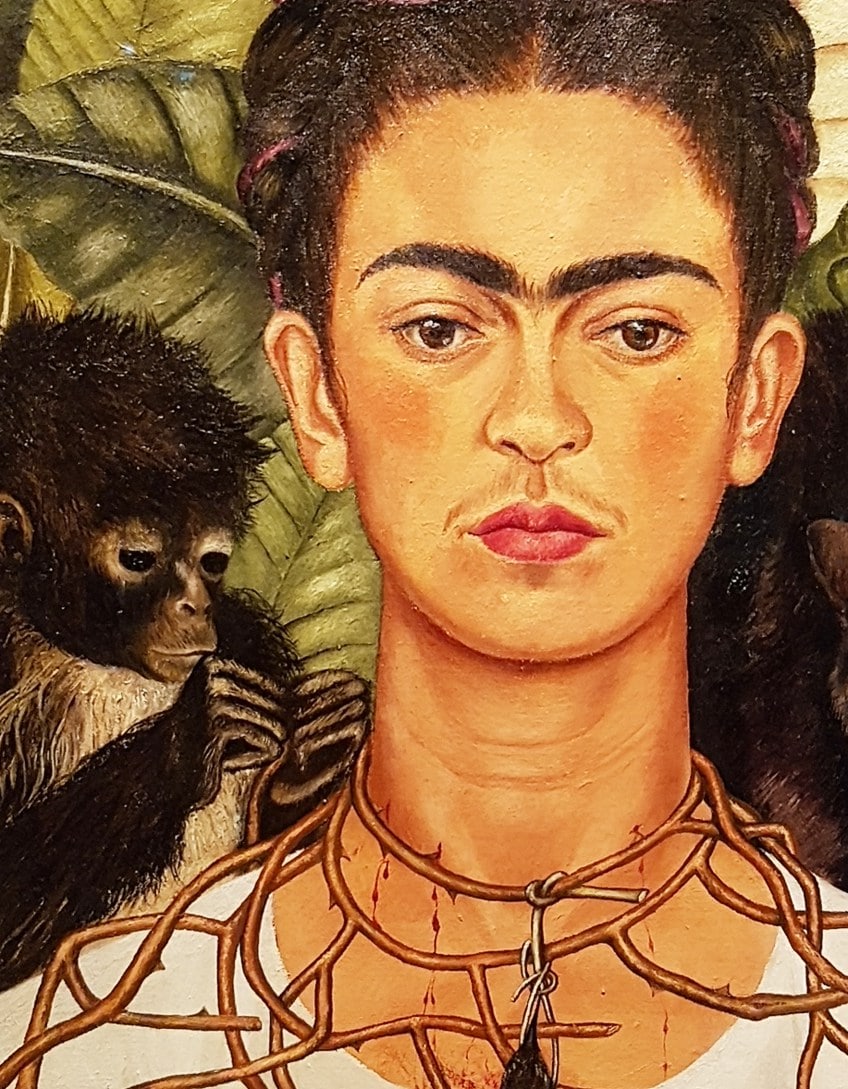
Color
The colors in Self-Portrait with Thorn Necklace and Hummingbird are mainly earthy and neutral hues like the greens for foliage, the brown for her skin tone, hair, and thorn necklace, the white of her blouse, and the black for the monkey, cat, and hummingbird. There is a hint of purple on her hair and red on her lips.
The background consists of cool colors, greens, and blues, which are associated with calmness or tranquility. The foreground appears warmer in color temperature, created, for example, by Kahlo’s skin tone.
Texture
Kahlo conveyed texture in different ways; for example, she utilized smoother brushstrokes for her skin and more varied, shorter brushstrokes to indicate the hair (fur and feathers) for the monkey, cat, and bird. There are smoother and longer brushstrokes for the foliage.
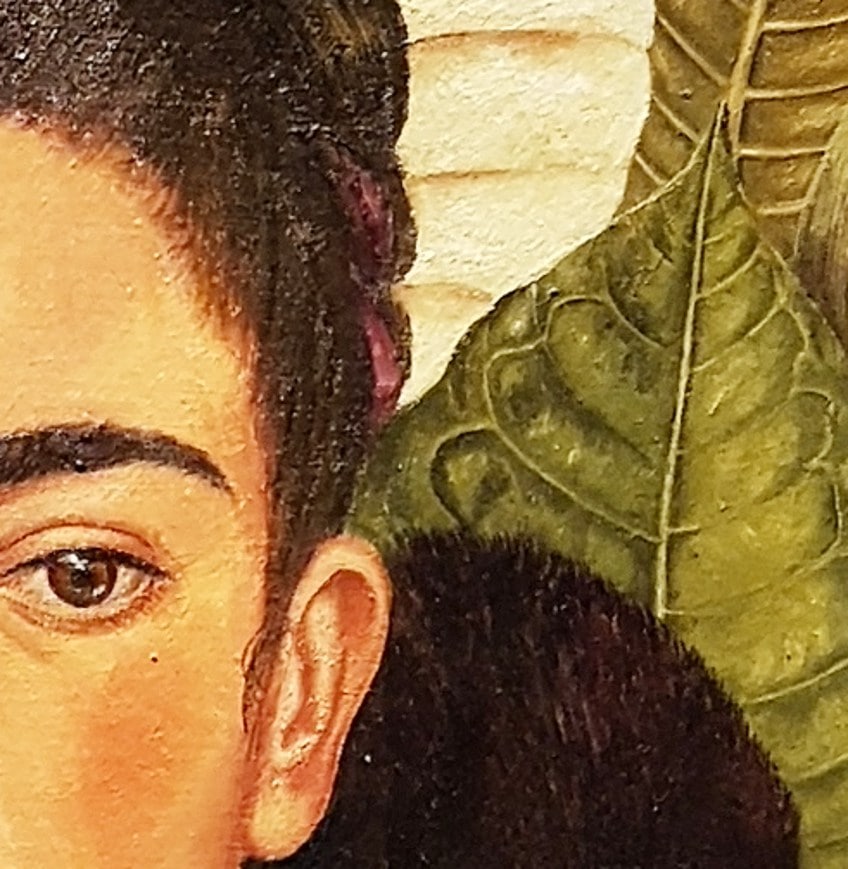
Furthermore, through color and shading Kahlo indicated texture, for example, the thorny necklace around her neck is given darker outlines to imply the texture of the thorny branches. The sky above appears more scumbled to indicate clouds.
The subtle shading on her neck gives the impression of the bones and tendons in her neck.
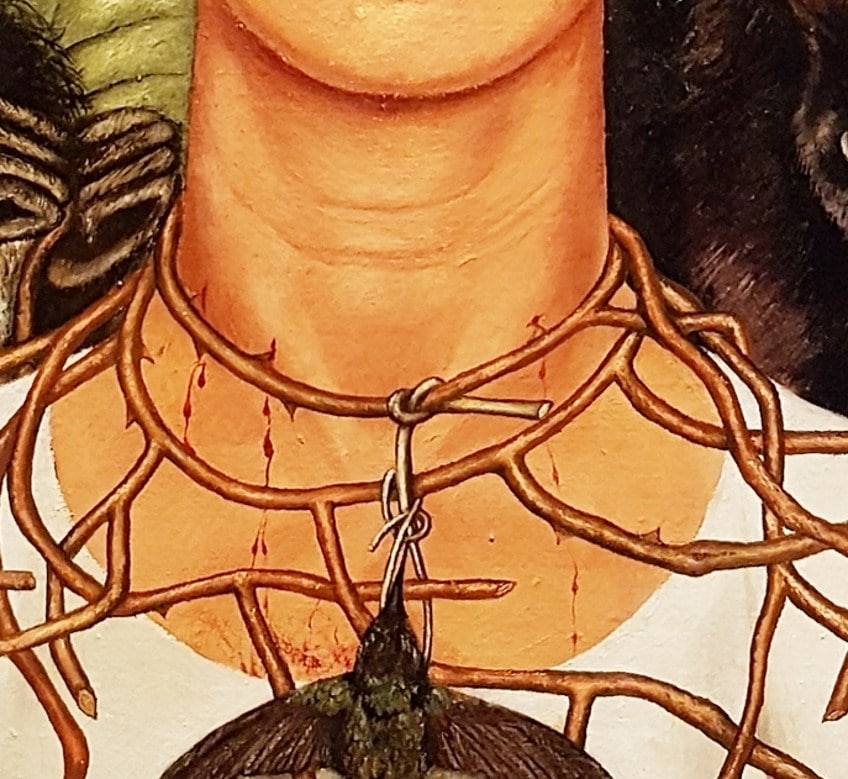
Line
There are various types of lines, mostly organic and naturalistic, in the Self-Portrait with Thorn Necklace and Hummingbird by Frida Kahlo, most notably curved and diagonal lines, which create a rhythm and pattern from their repetition.
This is evident in the curved lines from the leaves in the background echoed by the various diagonal lines from the thorny necklace around Kahlo’s neck, as well as the curving lines from the headdress on her hair and the boldened arcs from her eyebrows, which are also echoed by the arcs from her fainter mustache.
Additionally, the portrait orientation creates vertical linearity for the composition, which is coupled with the verticality of her neck and the faint vertical streams of blood from the cuts on it, but also contrasted by the horizontality of her shoulders in the lower portion of the composition.
The diagonal mishmash of lines created from the thorny necklace seemingly leads our gaze upwards to Kahlo’s face, emphasizing the subject matter and the deeper meanings inherent in the composition.
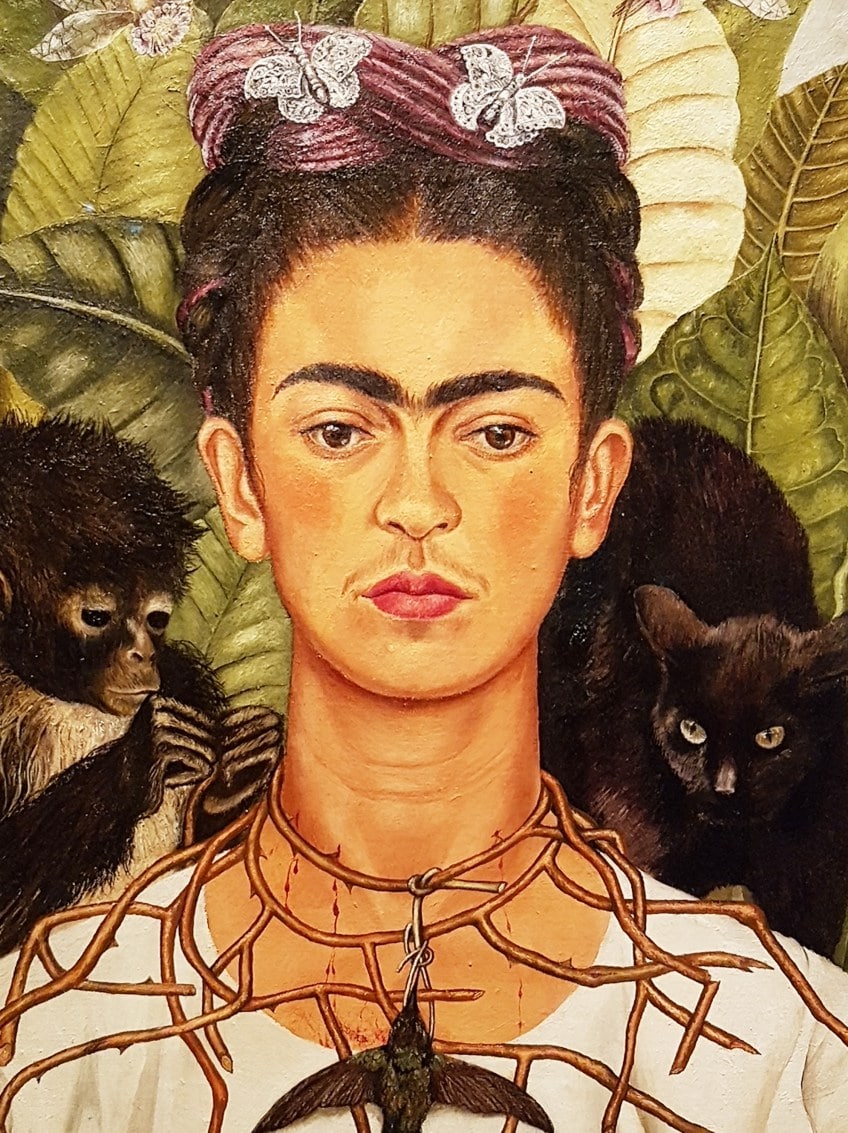
Shape and Form
Self-Portrait with Thorn Necklace and Hummingbird mostly consists of organic shapes and forms, which give the composition a naturalistic appearance. The organic curved and diagonal lines further create various shapes like the circles around Kahlo’s neck from the thorny necklace.
The negative space in between the necklace’s branches appears with more geometric, squared, and triangular shapes.
Additionally, there is depth created in the shading and tonality, giving a more three-dimensional form to Kahlo’s facial features as well as the darker shading in between the leaves in the background, which gives a layered effect.
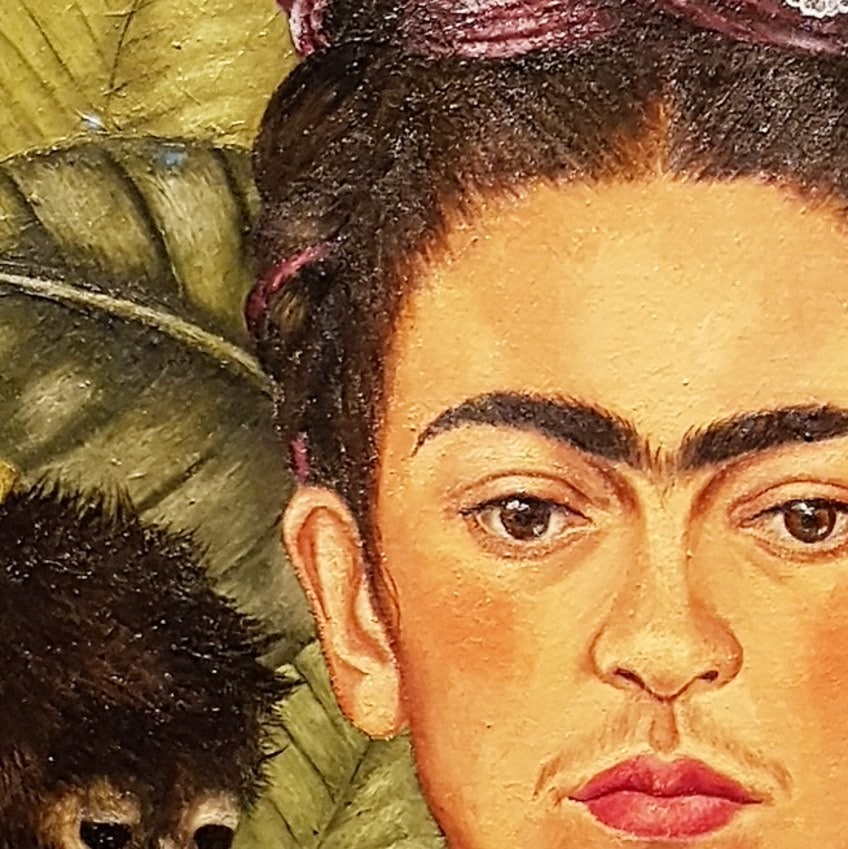
Space
There is a shallow space in Self-Portrait with Thorn Necklace and Hummingbird due to the leaves that create a backdrop effect, seemingly pushing Kahlo’s figure more into the foreground. Furthermore, the compositional space is full, from the leaves in the background to the animals surrounding Kahlo in the foreground.
All the above-mentioned aspects heighten the emotional intensity of the composition and place Kahlo face-to-face with us, the viewers, seemingly making us a part of the composition, and undoubtedly Kahlo’s direct gaze.
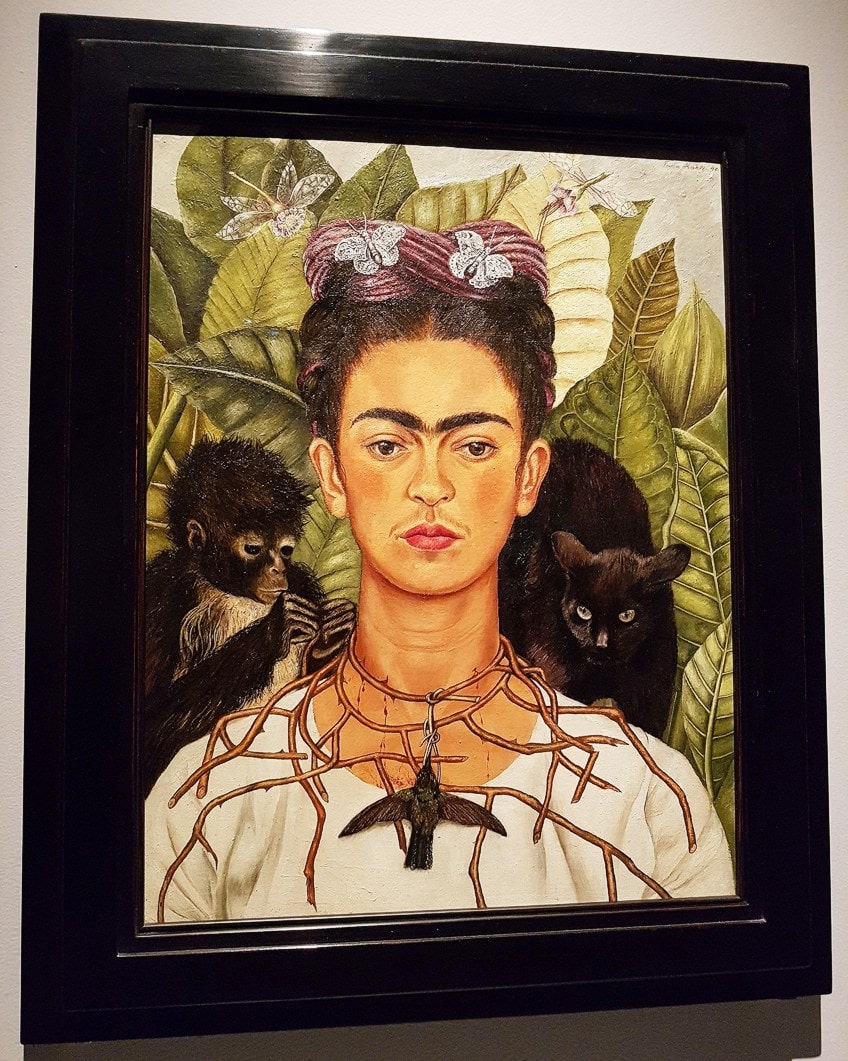
Frida Kahlo: A Self-Reflection
Self-Portrait with Thorn Necklace and Hummingbird by Frida Kahlo was a token and a gift to the world from her heart. The famous painting is over 80 years old, and it has continued to impact thousands of people. Its popularity has spanned several countries worldwide and was reportedly on loan to over 20 museums, the star of many exhibitions.
This and many other iterations of Frida Kahlo’s self-portrait depict her heartfelt and honest expressions and are tied up in an often-referred quote about how she described why she painted herself so many times, which she explained was because she was “often alone” and that she was “subject” she knew the best. You can learn more about this exceptional artist in our Frida Kahlo facts article.
Take a look at our Frida Kahlo self portrait webstory here!
Frequently Asked Questions
Who Is in the Thorn Necklace Painting?
Frida Kahlo portrayed herself in the thorn necklace painting Self-Portrait with Thorn Necklace and Hummingbird (1940). She painted 55 self-portraits during her art career and expressed her feelings and beliefs through her art.
What Is the Self-Portrait with Thorn Necklace and Hummingbird Meaning?
Self-Portrait with Thorn Necklace and Hummingbird (1940) by Frida Kahlo is often believed to refer to the idea of resurrection because of the various symbols like the butterflies, dragonflies, hummingbird, and allusion to Jesus Christ and the crown of thorns. It can also be a representation of Frida Kahlo’s lost love from her divorce and the related hardships she experiences throughout that time of her life.
What Does the Monkey Symbolize in Self-Portrait with Thorn Necklace and Hummingbird?
The monkey in Self-Portrait with Thorn Necklace and Hummingbird (1940) by Frida Kahlo is a spider monkey and is often believed to be a reference to Diego Rivera, who was her life partner, and who gave her a spider monkey. They divorced in 1939.
What Do the Thorn Necklace and Hummingbird Symbolize in Self-Portrait with Thorn Necklace and Hummingbird?
In Self-Portrait with Thorn Necklace and Hummingbird (1940) by Frida Kahlo, the thorn necklace is compared to the crown of thorns that Jesus Christ wore, which alludes to martyrdom. The hummingbird holds several meanings, the most common is its symbolism of good luck and of Huitzilopochtli, the Aztec god of war. In Kahlo’s painting, the hummingbird is dead and hanging from the thorn necklace, which could mean a loss of good luck or love.
What Is the Location of Self-Portrait with Thorn Necklace and Hummingbird?
Self-Portrait with Thorn Necklace and Hummingbird (1940) by Frida Kahlo is housed at the Harry Ransom Center in Austin, Texas, the United States (since 1965/1966). It was originally part of Nickolas Muray’s collection of art. Muray bought the painting from Frida Kahlo after she painted it.
Alicia du Plessis is a multidisciplinary writer. She completed her Bachelor of Arts degree, majoring in Art History and Classical Civilization, as well as two Honors, namely, in Art History and Education and Development, at the University of KwaZulu-Natal, South Africa. For her main Honors project in Art History, she explored perceptions of the San Bushmen’s identity and the concept of the “Other”. She has also looked at the use of photography in art and how it has been used to portray people’s lives.
Alicia’s other areas of interest in Art History include the process of writing about Art History and how to analyze paintings. Some of her favorite art movements include Impressionism and German Expressionism. She is yet to complete her Masters in Art History (she would like to do this abroad in Europe) having given it some time to first develop more professional experience with the interest to one day lecture it too.
Alicia has been working for artincontext.com since 2021 as an author and art history expert. She has specialized in painting analysis and is covering most of our painting analysis.
Learn more about Alicia du Plessis and the Art in Context Team.
Cite this Article
Alicia, du Plessis, ““Self-Portrait with Thorn Necklace and Hummingbird” – Frida Kahlo.” Art in Context. September 5, 2022. URL: https://artincontext.org/self-portrait-with-thorn-necklace-and-hummingbird/
du Plessis, A. (2022, 5 September). “Self-Portrait with Thorn Necklace and Hummingbird” – Frida Kahlo. Art in Context. https://artincontext.org/self-portrait-with-thorn-necklace-and-hummingbird/
du Plessis, Alicia. ““Self-Portrait with Thorn Necklace and Hummingbird” – Frida Kahlo.” Art in Context, September 5, 2022. https://artincontext.org/self-portrait-with-thorn-necklace-and-hummingbird/.


